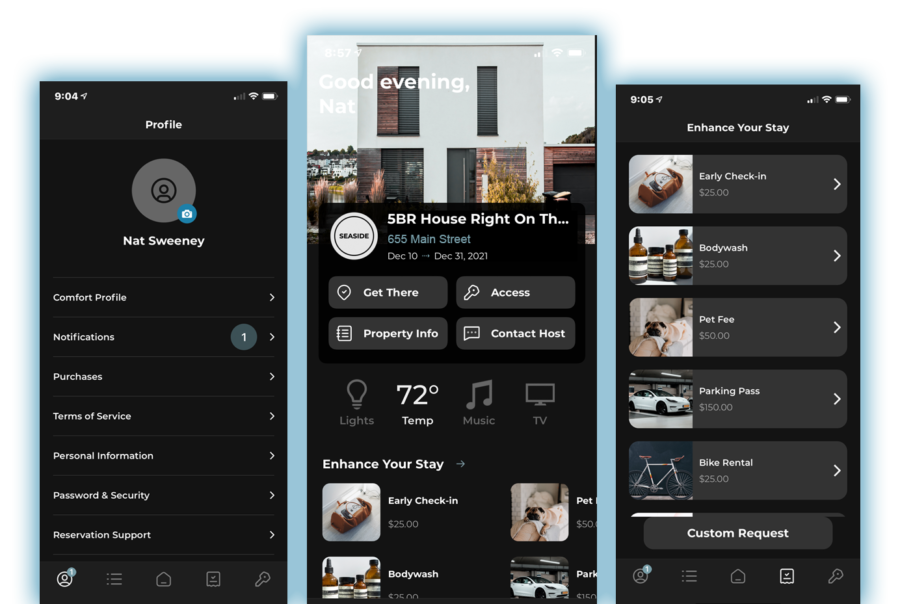My objective was to assess the app and propose recommendations to enhance engagement and further increase revenue-generating opportunities.
Revamping DACK's Customer App to Boost Engagement and Revenue
I spearheaded a project to enhance the user experience of DACK’s customer-facing app, which serves rental property operators and guests. Despite the app’s initial success, it faced declining engagement after adding numerous features. My goal was to simplify navigation, clarify value propositions, and improve user interactions to increase engagement and revenue. Through in-depth analysis, wireframing, and design, I redefined core objects like Trip and Property, streamlined the app's navigation, and introduced a discount model for local businesses. This approach aimed to create a more intuitive and valuable digital experience, fostering deeper customer relationships and additional revenue opportunities.

DACK provides technology to rental property operators. Its powerful operator portal allows operators to control, customize, and manage the guest experience, messaging, verification, check-in / check-out, and more. It also has a customer-facing app that gives customers control over their stay.
I was tasked with reviewing their customer-facing app and making suggestions for improving the user experience.
Goals and Objectives
Research Phase
Initially, I reviewed the app, utilized it, and studied its features extensively. This involved forming a clear understanding of DACK and its benefits to users.
The app’s structure comprised various sections, including reservations, property details, enhancing the stay, and local attractions. However, the navigation felt convoluted, leading to confusion among users.


Defining DACK's Value for Customers
Through analysis, I identified key customer values as:
- A better way to stay
- Share digital access
- Customize & enhance the stay
- Connect to experiences
- Tech controls
To simplify and streamline DACK, I condensed these values into five core objects:

USER holds the profile of our users. (Guest, Host, & Services)
The purpose of this object is to allow communication and payment between users

PROPERTY is the physical place a guest can rent from a host.
The purpose of the property object is a place to go to interact with things inside the property or about the property.

TRIP is an experience defined by dates a uses rents from a host
The purpose of this object is to allow users to see what encompasses their whole experience, who will join them, what they have added, what more they can add.

ENHANCMENTS can be anything that might make a user’s trip more enjoyable, easier, or convenient.
The purpose of this object is for our:
Host is to gain additional revenue and better customer engagement.
Guests is to further the enjoyment/satisfaction of their trip.

LOCAL DISCOUNTS allows local businesses to advertise discounts to DACK guests during their stay.
The purpose of this object is to enhance the customer experience beyond their initial rental.
By understanding the relationships, attributes, and actions (CTAs) users could take with these objects, I developed a coherent navigation flow.
Refining DACK’s Value Proposition:
For Hosts:
- DACK’s platform facilitates end-to-end customer experiences, fostering additional revenue, enhanced security, service management, and deeper customer relationships.
For Guests:
- DACK offers digitally enhanced amenities and property guidance for a convenient, customer-centric stay, with the option for hosts to provide memorable enhancements.
Wireframing and Design
I began the design process by focusing on the app’s existing “Place” feature, encompassing various functionalities. By redefining objects like Trip and Property, I aimed to simplify user interactions and improve clarity.
-
My trip is where I go to see what encompasses my full experience, who will be joining me, what perks I have added and what more I might want to add
-
Property is where I get information about the property I am renting and where I can digitally control it

Trip
The Trip object defines the experience based on the dates a user rents from a host.
In the My Trip section:
-
Users access all relevant information about their planned trip.
-
Details include accommodation specifics.
-
Users can view any enhancements that have been added or are under consideration.
-
A list of individuals joining the trip is provided.
The app can seamlessly connect these dots by leveraging the relationships between objects, Users, and Enhancements, ensuring a coherent and user-friendly experience.
Property
The Property object represents a guest’s physical place rented from a host. Its purpose is to serve as a centralized hub for interacting with aspects inside or related to the property.
Property Section:
-
Easily accessible property information.
-
The design aims for intuitive user navigation.
-
Tasks include accessing property with a virtual key and controlling devices.
-
Consolidates relevant information and functionalities.
Users can navigate effortlessly and efficiently by consolidating all relevant information and functionalities in one place.
